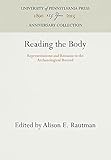Reading the Body : Representations and Remains in the Archaeological Record / ed. by Alison E. Rautman.
Material type: TextSeries: Regendering the PastPublisher: Philadelphia : University of Pennsylvania Press, [2016]Copyright date: ©2000Edition: Reprint 2016Description: 1 online resource (288 p.) : 41 illusContent type:
TextSeries: Regendering the PastPublisher: Philadelphia : University of Pennsylvania Press, [2016]Copyright date: ©2000Edition: Reprint 2016Description: 1 online resource (288 p.) : 41 illusContent type: - 9780812235210
- 9781512806830
- 930.1/028/5 21
- CC72.4
- online - DeGruyter
- Issued also in print.
| Item type | Current library | Call number | URL | Status | Notes | Barcode | |
|---|---|---|---|---|---|---|---|
 eBook
eBook
|
Biblioteca "Angelicum" Pont. Univ. S.Tommaso d'Aquino Nuvola online | online - DeGruyter (Browse shelf(Opens below)) | Online access | Not for loan (Accesso limitato) | Accesso per gli utenti autorizzati / Access for authorized users | (dgr)9781512806830 |
Frontmatter -- Contents -- List of Figures -- List of Tables -- 1. Introduction: Diverse Approaches to the Study of Gender in Archaeology -- 2. Writing the Body in Archaeology -- Part I. Reading the Body from Mortuary Remains -- 3. Sex, Health, and Gender Roles Among the Arikara of the Northern Plains -- 4. Labor Patterns in the Southern Levant in the Early Bronze Age -- 5. Reconstructing the Lives of South Etruscan Women -- 6. Gender in Inuit Burial Practices -- 7. The Status of Women in Predynastic Egypt as Revealed Through Mortuary Analysis -- Part II. Reading the Body from Representations of the Human Form -- 8. The Human Form in the Late Bronze Age Aegean -- 9. Deciphering Gender in Minoan Dress -- 10. Fear and Gender in Greek Art -- 11. Mississippian Weavers -- 12. Prehistoric and Ethnographic Pueblo Gender Roles: Continuity of Lifeways from the Eleventh to the Early Twentieth Century -- 13. And They Said, Let Us Make Gods in Our Image: Gendered Ideologies in Ancient Mesopotamia -- 14. Beyond Mother Earth and Father Sky: Sex and Gender in Ancient Southwestern Visual Arts -- 15. Father Earth, Mother Sky: Ancient Egyptian Beliefs About Conception and Fertility -- 16. Female Figurines in the European Upper Paleolithic: Politics and Bias in Archaeological Interpretation -- References -- Contributors -- Index
restricted access online access with authorization star
http://purl.org/coar/access_right/c_16ec
Classical and anthropological archaeologists share many of the same interests and confront many of the same problems studying extinct cultures. Despite differences in background and training, scholars in these disciplines are all engaged in analyzing and interpreting the archaeological record. Traditionally, however, there have been few opportunities for classical archaeologists and anthropologists to discuss mutually beneficial perspectives in method and theory. The study of gender and its representations affords an opportunity for archaeologists and anthropologists to share information and increase our understanding of how people lived in the past. Reading the Body contains current anthropological and archaeological research about the body and the archaeological record-both physical remains and artistic representations-from sites all over the world ranging in time from the European Upper Paleolithic to the Pueblo societies of the recent past. Essay topics include the reconstruction of the lives of Etruscan women from skeletal remains, gender symbolism in Inuit burials, the erotic clothing of Crete's Minoan culture, and gender identities in Maya ceramic paintings.
Issued also in print.
Mode of access: Internet via World Wide Web.
In English.
Description based on online resource; title from PDF title page (publisher's Web site, viewed 24. Apr 2022)


